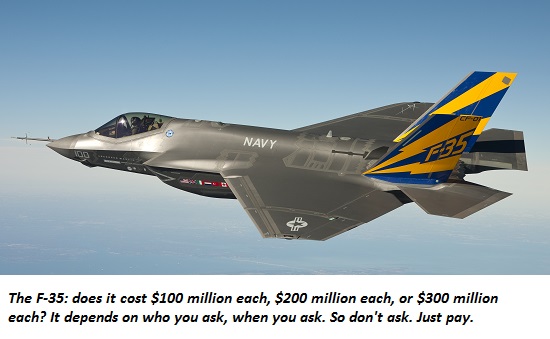Cancel the F-35 and Build 21st Century Air Superiority with Drones
June 4, 2015
Our focus should not be on the glory of the past (piloted aircraft) or protecting institutional turf but on building a true air superiority fleet of drones that the nation can actually afford.
The tragedy of broken systems is they eventually reach a perfection of their pathologies. In the U.S. weapons acquisition system, that ultimate failure is the F-35 Joint Strike Fighter (JSF). It is painful to read this recent summary of how we got stuck with the unaffordable and inferior F-35: How the U.S. and Its Allies Got Stuck with the World’s Worst New Warplane.

Supporters of the F-35 will quibble, of course--who in the Pentagon or Lockheed is going to stand up and declare the aircraft is a failure and we need to start over?
My critique is far more radical than the conventional criticisms of the F-35 program. The problem isn't just the one-design-fits-all-services failure, or the software failures, or the issue of being underpowered and underarmed, or the horrendous cost overruns--any one of which would have doomed the program had the system not been broken.
In my view, it's absolutely insane to risk pilots in combat when there is no longer any need to do so.
When you think about it rationally, it's crazy to invest hundreds of thousands of dollars in training pilots and then risk their lives in combat when they could be safely on the ground (or on board a distant ship) doing the same job.
It is equally insane to burden an aircraft with the constraints of keeping the pilot alive. A drone flown by a ground-based pilot can jink (maneuver) in ways that a piloted aircraft cannot, as pilots black out in high-G maneuvers.
All the systems needed to keep the pilot alive can be jettisoned in a drone. That lowers the weight and the cost considerably.
Pilots are not expendable, and neither are $300 million aircraft. When the cost of a weapons system reaches absurd heights, no nation can afford to build and maintain very many of the weapons. As a result, when combat looms, commanders are limited by the likelihood that the unavoidable losses of combat will quickly deplete the force.
The whole point of drones is they're expendable. If they're designed to be built cheaply, commanders can afford to sacrifice a great many drones to force the opponent into a war of attrition.
The other advantage of drones is they can be tailored to a variety of combat situations. It is easy to envision an air superiority fleet that operates a wide range of drones, from small aircraft designed to have near-zero radar signatures to large drones that are basically platforms to get various kinds of fire and forget air-to-air missiles (stand-off missiles such as the AMRAAM or short-range Sidewinders) within range of enemy aircraft.
Small highly maneuverable drones could act as self-guided sacrificial weapons, essentially designed to get in the way of enemy aircraft and drones and destroy them on impact.
After throwing layers of such deadly but dispensable drones at an enemy force, what was left of the enemy would face a smaller force of air-superiority drones with multiple armaments.
The history of aircraft development offers numerous examples of the right and wrong way to design and build game-changing weapons systems. Aircraft intended to serve the very different needs of the Navy, Marines and Air Force are generally failures, for self-evident reasons: by the time every service's specifications have been thrown in, the aircraft cannot perform well and is hyper-costly.
Aircraft designed by committee and political meddling that stretch over decades are always costly failures.
Successful aircraft are designed by a handful of experienced engineers in a skunkworks protected from design-by-committee Pentagon brass and politicians angling for defense contracts in their district. The engineers are not hampered by an impossible list of "and it also has to do this" specs. They are free to design an aircraft using off-the-shelf components that does a few things extremely well.
The mission goal is clear but the means to reach that goal are not specified.
Sadly, our nation's ability to design and build successful aircraft is completely hobbled by the broken system of design-by-committee and the political dominance of too-big-to-cancel defense contractors and their politico lackeys.
The sunk costs of the F-35 are now so high that it is impossible for the institutional players to let go of it, even though they know the program is 1) unaffordable and 2) a failure.
Anyone who values pilots and understands that weapons systems designed to be everything to everybody are doomed to operational failure and cost overruns would not hesitate to cancel the F-35 albatross in a second.
Our focus should not be on the glory of the past (piloted aircraft) or protecting institutional turf but on building a true air superiority fleet of drones that the nation can actually afford.
What the nation needs in 2016 is a president with the courage and fortitude to cancel failed weapons programs like the F-35 and move beyond outdated paradigms that put more emphasis on protecting federal fiefdoms and spending than they do on affordable military superiority.
We can still indulge the illusion that we have a choice--shall we build a fleet of aircraft that cost over $200 million each and requires $560 billion to maintain and operate over its service life? This choice is false, as we cannot afford $1 trillion programs for outdated weapons. This will become painfully obvious in the decade ahead.
NOTE: Contributions/subscriptions are acknowledged in the order received. Your name and email remain confidential and will not be given to any other individual, company or agency.
|
Thank you, Maynard W. ($5/month), for your fantastically generous subscription to this site-- I am greatly honored by your steadfast support and readership. |